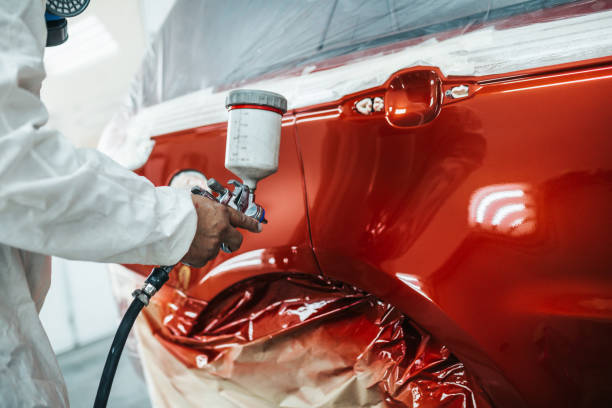
How Are Automotive Paint Innovations Shaping Efficiency, Sustainability, and Market Expansion?
Share
According to the report by Next Move Strategy Consulting, the global Automotive Paints Market size is predicted to reach USD 11.49 Billion by 2030 with a CAGR of 5.4% from 2024-2030.
Automotive paints have evolved far beyond simple colour applications to become critical enablers of efficiency, sustainability, and market growth. In this blog, we explore three key developments from leading original equipment manufacturers (OEMs) and coatings specialists—ABB, JSW Paints, and Axalta—that illustrate how advanced atomization, strategic market entry, and digital inkjet technologies are redefining automotive paint shops and coatings markets.
How Can an Advanced Paint Atomizer Improve Transfer Efficiency and Reduce Waste?
ABB’s introduction of the RB 1000i‑S paint atomizer exemplifies how precision engineering can drive both operational efficiency and environmental benefits in automotive paint shops.
Short Conclusive Statement:
By increasing transfer efficiency and cutting waste, the RB 1000i‑S not only lowers material costs but also supports carbon‐neutral ambitions.
- Transfer Efficiency Gains: Up to 10% improvement over the predecessor model.
- Cost Savings Example: A facility painting 200,000 vehicles annually can save 50,000 L of paint—equivalent to USD 500,000 in direct savings (assuming USD 10 per litre).
- Upgrade Path: Existing RB 1000i units can be retrofitted via service kits (bell cup and shaping air nozzle replacements) to extend equipment life and minimize waste.
What Does JSW Paints’ Move into Automotive Coatings Mean for the Indian Market?
According to the report by Machine Maker, JSW Paints, having achieved operational profitability in other segments, is leveraging its parent group’s automotive joint venture to enter the Indian automotive coatings arena.
Short Conclusive Statement:
JSW Paints’ strategic market entry is poised to capitalize on robust sector growth, underpinned by domestic innovation and significant capital infusion.
- Technology Strategy: In‐house development with openness to partnerships for faster technology rollout.
- Competitive Landscape: Direct competition with established players such as Akzo Nobel NV, Berger Paints India, Kansai Nerolac, Nippon Paint (India), and PPG Asian Paints.
- Market Growth Projections: Indian automotive coatings market expected to grow from USD 608 million in 2023 to USD 911 million by 2028 at a CAGR of 8%.
- Capacity Expansion: JSW MG Motors plans to triple vehicle production capacity from 100,000 to 300,000 units per annum, launching models including the Cyberster EV.
Why Is Axalta’s Next Jet Technology Transforming Automotive Coating Applications?
According to Coatings World, Axalta Next Jet™ brings digital inkjet precision to two-colour and graphics applications in OEM paint shops, delivering substantial cost, labour, and emission reductions.
Short Conclusive Statement:
By replacing conventional masking and foil processes, Next Jet achieves near‐100% transfer efficiency, dramatically reducing costs and carbon footprints.
- Technology Overview: Piezoelectric inkjet application paired with proprietary paint formulations, co‐innovated with Xaar and integrated with Dürr robotics.
- Cost Reductions: Approximately 70% lower incremental cost for second‐colour (Tutone) applications by eliminating masking material and labour.
- Emission Savings: 30% reduction in Scope 1 CO₂ emissions via Axalta’s COATS modelling tool.
- Application Precision: Up to 720 DPI graphics resolution without foils, enabling seamless, long‐lasting designs directly under clearcoat.
- Industry Recognition: Named a 2025 Automotive News PACE Pilot Innovation to Watch; high designer, engineer, and sustainability professional interest.
Next Steps: Actionable Takeaways
- Evaluate Atomizer Upgrades
- Pilot ABB’s RB 1000i‑S atomizer or retrofit kit to quantify transfer efficiency and waste reductions in your paint shop.
- Plan Market Entry or Expansion
- For coatings suppliers: assess partnership or in‐house development strategies similar to JSW Paints to enter automotive segments.
- Adopt Digital Inkjet Solutions
- Investigate Axalta Next Jet or equivalent inkjet technologies for specialized two-colour and graphics applications to reduce masking workflows and emissions.
- Model Sustainability Benefits
- Use CO₂ and VOC emission modelling (e.g., Axalta’s COATS tool) to build a business case for technology investments.
- Monitor Regulatory Targets
- Align paint shop upgrades with carbon‐neutral factory goals (e.g., 2035 commitments) to meet both compliance and Corporate Social Responsibility objectives.
By integrating advanced atomization, strategic market positioning, and digital coating technologies, automotive manufacturers and suppliers can significantly enhance efficiency, drive sustainability, and capture emerging market opportunities—paving the way toward smarter, greener paint shops and coatings solutions.